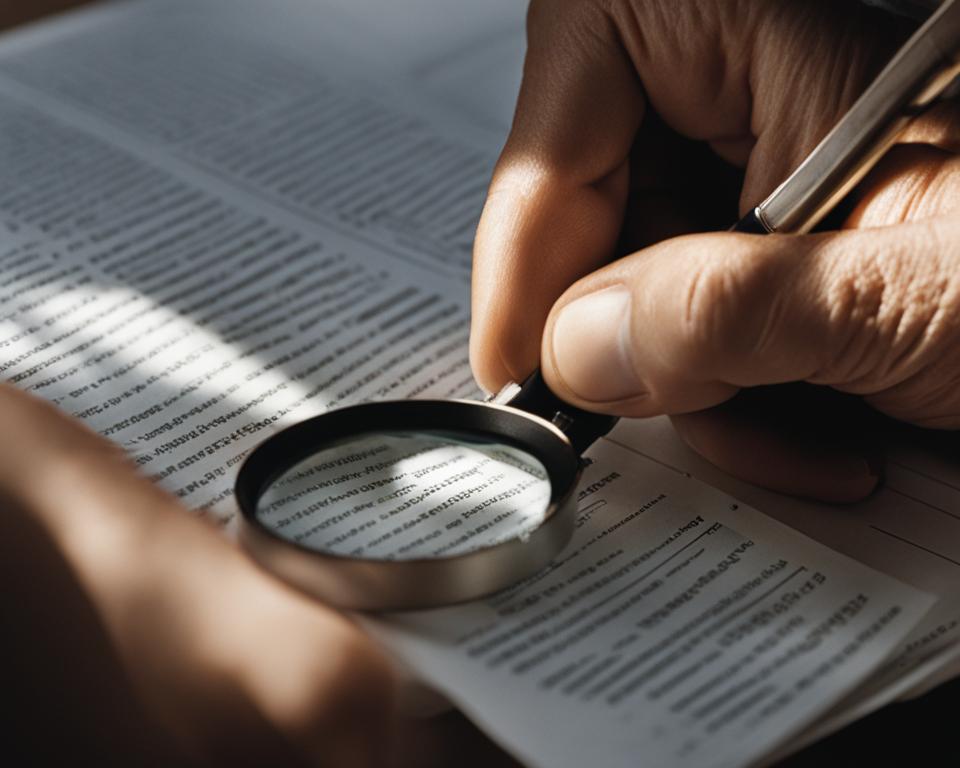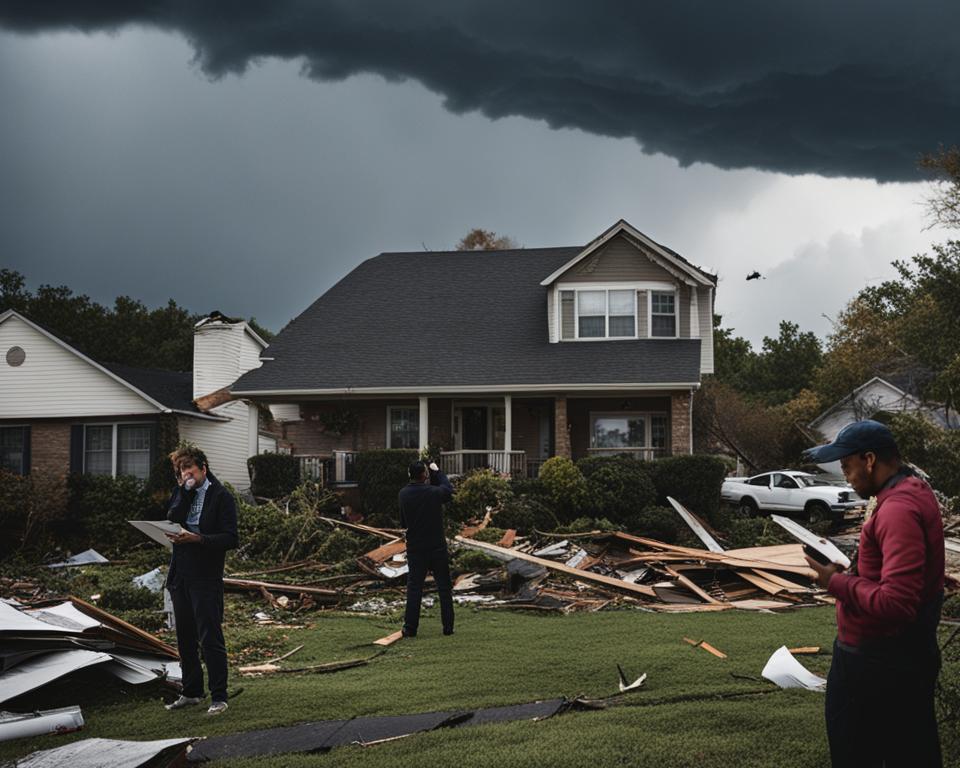When severe weather events, such as storms, hail, or strong winds, damage your property, it’s crucial to understand the storm damage insurance claims process. This article will guide you through the necessary steps to successfully file an insurance claim for storm damage. With proper navigation and documentation, you can ensure that you receive the compensation you need to restore your property.
Key Takeaways:
- Understand the necessary steps to file an insurance claim for storm damage.
- Thoroughly assess and document the extent of the damage to your property.
- Review your insurance policy to understand your coverage limits and exclusions.
- Promptly contact your insurance company with all the necessary information.
- Obtain multiple repair estimates to support your claims process.
Assessing the Damage
The first step in the storm damage insurance claims process is to assess the extent of the damage to your property. Thoroughly inspect your property for signs of damage, such as missing shingles, dents, cracks, or leaks. Take photographs or videos to document the damage, as visual evidence will be crucial during the claims process.
When inspecting your property, pay attention to both the exterior and interior. Examine the roof, siding, windows, doors, and any other vulnerable areas that may have been affected by the storm. Take note of any structural damage or potential hazards that could pose a safety risk.
Gathering evidence is vital to support your insurance claim. In addition to photographs and videos, make detailed notes about the damage you observe. Include information about the date and time of the storm, the specific areas impacted, and any immediate action you took to prevent further damage.
| Damage | Description |
|---|---|
| Missing shingles | Noticeable gaps in the roof with exposed underlayment. |
| Dents | Visible dents or dimples on metal surfaces, such as gutters or air conditioning units. |
| Cracks | Visible cracks in the foundation, walls, or concrete surfaces. |
| Leaks | Water stains or active leaks in ceilings, walls, or floors. |
Remember, accurate documentation and evidence are essential when filing an insurance claim for storm damage. This information will help support your case and ensure that you receive the necessary compensation for repairs and restoration.
Next Steps:
- Review your insurance policy to understand your coverage.
- Contact your insurance company to initiate the claims process.
- Obtain multiple repair estimates from reputable contractors.
Reviewing Your Insurance Policy
Before filing a claim for storm damage, it’s crucial to thoroughly review your insurance policy to understand the coverage you have. By familiarizing yourself with the details of your policy, you can ensure that you are aware of the coverage limits, deductibles, and any exclusions that may apply to your situation.
Start by carefully reading through your policy document, paying close attention to the sections that outline coverage for property damage due to storms or natural disasters. Take note of any specific limitations or exceptions that may impact your claim.
It is also important to understand the coverage limits, which are the maximum amount your insurance company will pay for a covered loss. This will help you determine if the damage to your property falls within the coverage limits specified in your policy.
Key Points to Review in Your Insurance Policy:
- Check the coverage limits for storm damage to your property.
- Identify the deductible amount you will be responsible for paying before your insurance coverage kicks in.
- Look for any exclusions or limitations that may impact your claim.
By reviewing your policy in detail, you can ensure that you have a clear understanding of your coverage and are prepared to navigate the storm damage insurance claims process effectively.

Contacting Your Insurance Company
Once you have assessed the damage to your property and reviewed your insurance policy, the next step in the storm damage insurance claims process is to contact your insurance company. This step is crucial in initiating the claims process and ensuring that you receive the compensation you need to restore your property.
When reaching out to your insurance company, be prepared to provide them with all the necessary information related to the storm damage. This includes the date of the damage and a detailed description of what occurred. The more information you can provide, the better equipped your insurance company will be to assess your claim.
It’s important to contact your insurance company promptly after the storm damage occurs. Many insurance policies have specific time limits for filing claims, so it’s essential to act quickly to avoid any potential delays or complications.
Obtaining Estimates
When it comes to filing an insurance claim for storm damage, obtaining accurate repair estimates is a crucial step in the claims process. By obtaining multiple estimates from reputable contractors, you can ensure that you have a comprehensive understanding of the scope of work required and the associated costs.
Detailed documentation of the storm damage and the repair estimates will provide valuable evidence to support your insurance claim. Make sure that the estimates include a clear breakdown of the work to be done and the corresponding costs. This information will help your insurance company assess the necessary coverage for the repairs.
By obtaining multiple estimates, you can compare the recommendations and prices provided by different contractors. This will allow you to make an informed decision and choose the contractor that best fits your needs and budget. Remember, the lowest estimate may not always be the best option, as quality and reputation should also be taken into consideration.
Gathering Detailed Repair Estimates
When obtaining repair estimates, it’s important to gather as much detailed information as possible. This includes:
- Scope of work: Ensure that the estimate clearly outlines the specific repairs that need to be undertaken, including any materials, parts, or labor required.
- Itemized breakdown of costs: The estimate should provide a detailed breakdown of the costs associated with each repair item, such as materials, labor, and any additional fees.
- Timeline: Ideally, the estimate should include an estimated timeline for completing the repairs. This will help you plan and coordinate with your insurance company.
By gathering these detailed estimates, you will have the necessary documentation to support your insurance claim and ensure a smoother claims process.
Table: Example Repair Estimates Comparison
| Contractor | Scope of Work | Itemized Costs | Timeline |
|---|---|---|---|
| ABC Contractors | Replace damaged roof shingles, repair gutter, and seal cracks in the foundation. | $5,000 – Roof shingle replacement: $3,000, Gutter repair: $1,000, Foundation crack sealing: $1,000 | 2 weeks |
| XYZ Restoration | Replace damaged roof shingles, repair gutter, and perform a thorough inspection for hidden damage. | $8,500 – Roof shingle replacement: $4,000, Gutter repair: $2,500, Inspection: $2,000 | 3 weeks |
| 123 Construction | Replace damaged roof shingles, repair gutter, and conduct necessary structural repairs. | $7,200 – Roof shingle replacement: $3,500, Gutter repair: $1,200, Structural repairs: $2,500 | 4 weeks |
Table: Comparison of repair estimates from different contractors for storm damage repairs. The estimates include the scope of work, itemized costs, and estimated timelines. This table can help you make an informed decision based on the details provided by each contractor.

Meeting with the Adjuster
When navigating the storm damage insurance claims process, a crucial step is meeting with the insurance adjuster. The adjuster plays a vital role in assessing the extent of the damage and determining the compensation you will receive. This meeting is an opportunity for you to provide additional documentation and communicate any concerns or questions you may have.
During the inspection, the insurance adjuster will carefully assess the storm damage to your property. It’s important to be present during this meeting to ensure that all the damage is properly documented. You can point out specific areas of concern and provide any additional evidence, such as photographs or videos, that support your claim.
Documenting the Damage
During the meeting with the insurance adjuster, it’s crucial to thoroughly document the damage to your property. Take detailed notes and photographs of the affected areas, highlighting any visible signs of storm damage. This documentation will serve as valuable evidence during the claims process and can help ensure that you receive fair compensation.
Additionally, if you have undergone any temporary repairs to prevent further damage, be sure to provide documentation of these efforts. This can include invoices or receipts for materials and labor. Keeping a detailed record of the damage and your mitigation efforts will strengthen your claim and demonstrate your proactive approach.
Effective Communication
Clear and effective communication with the insurance adjuster is essential to successfully navigate the claims process. Be prepared to answer any questions the adjuster may have about the damage, the cause of the storm, or any previous repairs. It’s important to remain calm and professional while discussing the details of your claim.
If you have any concerns or questions during the meeting, don’t hesitate to ask for clarification. The insurance adjuster is there to assist you and ensure a fair evaluation of your claim. Taking the time to engage in open and honest communication can help address any uncertainties and ensure that the claims process proceeds smoothly.
| Meeting with the Adjuster Tips: |
|---|
| Be present during the inspection to provide additional documentation and address any concerns. |
| Thoroughly document the damage with detailed notes and photographs. |
| Provide evidence of any temporary repairs or mitigation efforts. |
| Communicate clearly and calmly, addressing any questions or concerns raised by the adjuster. |
Understanding Your Coverage
When it comes to storm damage insurance claims, understanding your coverage is essential. Insurance policies can vary in terms of the extent of coverage they provide. Familiarizing yourself with the specifics of your policy can help you navigate the claims process more effectively and manage your expectations regarding compensation.
There are generally two types of coverage when it comes to storm damage: full coverage and partial coverage. Full coverage policies typically cover the entire cost of repairs or replacement, while partial coverage policies only cover a portion of the expenses. It’s important to review your policy to determine which type of coverage you have.
In addition to coverage limits, it’s crucial to be aware of any deductibles or additional costs that may apply. Deductibles are the amount you’ll need to pay out of pocket before your insurance coverage kicks in. Understanding these costs can help you budget and plan accordingly.
Table: Types of Coverage and Associated Costs
| Policy Type | Coverage | Deductibles | Additional Costs |
|---|---|---|---|
| Full Coverage | Cost of repairs or replacement | Typically lower or no deductibles | No additional costs |
| Partial Coverage | Portion of the expenses | Varies, usually higher deductibles | Possible additional costs |
By understanding your coverage, you can set realistic expectations and be prepared for any out-of-pocket expenses that may arise. If you have any questions or uncertainties, it’s always advisable to contact your insurance company for clarification.
Keeping Documentation
When dealing with storm damage insurance claims, keeping detailed records is crucial for a smooth and successful claims process. By maintaining organized documentation of your expenses, invoices, receipts, and the entire repair process, you can provide the necessary proof and support for your insurance claim.
Throughout the repair process, it’s important to keep track of all expenses related to the storm damage. This includes invoices from contractors, receipts for materials purchased, and any other costs incurred during the repairs. These records will serve as evidence of the work done and the costs involved, helping to justify your claim.
Gathering Invoices and Receipts
Make sure to gather all the invoices and receipts related to the storm damage repairs. Organize them in a logical manner, such as by date or by the type of expense. This will make it easier to present the documentation to your insurance company when required.
| Date | Expense | Amount |
|---|---|---|
| June 15, 2022 | Roof Repair | $2,500.00 |
| June 20, 2022 | Window Replacement | $1,200.00 |
| June 25, 2022 | Flooring Repair | $1,800.00 |
Recording the Repair Process
In addition to financial documentation, it’s important to record the repair process itself. Take photographs or videos before, during, and after the repairs to document the extent of the damage and the quality of the work done. This visual evidence can be invaluable in supporting your claim and proving that the necessary repairs were completed.
By keeping detailed records throughout the storm damage insurance claims process, you can ensure that you have the necessary documentation to support your claim. This will help you navigate the claims process more effectively and increase your chances of receiving the compensation you deserve.
Completing the Repairs and Submitting Final Documentation
Once the necessary repairs to your property in accordance with industry standards and local building codes have been completed by a qualified contractor, it is time to submit the final documentation to your insurance company. This documentation should include invoices, receipts, and any other relevant paperwork that demonstrates the work that has been done.
It is important to ensure that the repairs were carried out according to the required industry standards and local building codes. This will help to ensure that your property is restored to its pre-damage condition and will also facilitate the claims process with your insurance company.
By submitting the final documentation, you provide your insurance company with the necessary evidence to assess the work that has been done and the associated costs. It is crucial to maintain accurate records of all expenses, invoices, and receipts to support your claim.
Upon approval of your final documentation, your insurance company will provide compensation for the covered expenses, enabling you to recover the financial costs incurred as a result of the storm damage. Remember to follow up with your insurance company to confirm the status of your claim and ensure a prompt resolution to your storm damage insurance claim.
FAQ
What should I do if my property is damaged by a storm?
The first step is to thoroughly inspect your property for signs of damage and document it with photographs or videos. Then, review your insurance policy to understand your coverage. Contact your insurance company to initiate the claims process.
How do I assess the extent of the damage?
Thoroughly inspect your property for missing shingles, dents, cracks, or leaks. Take photographs or videos to document the damage as visual evidence.
What should I do before filing a storm damage insurance claim?
Carefully review your insurance policy to understand the coverage limits, deductibles, and exclusions that may apply. Having a clear understanding of your policy will help you navigate the claims process more effectively.
How do I contact my insurance company to file a claim?
Contact your insurance company and provide them with the necessary information, including the date of the damage and a detailed description of what occurred.
Should I obtain multiple estimates for repairing the storm damage?
Yes, it’s recommended to obtain multiple estimates from reputable contractors. These estimates will serve as valuable documentation during the claims process.
What happens during the meeting with the insurance adjuster?
The insurance adjuster will inspect the storm damage to your property. It’s important to be present during this meeting to discuss the damage and provide any additional documentation or evidence.
Will my insurance policy cover the full cost of repairs?
It depends on your policy. Some policies provide full coverage, while others may only cover a portion of the expenses. Review your policy to understand any deductibles or additional costs you may be responsible for.
Why is keeping documentation important during the storm damage repair process?
Keeping detailed records of all expenses, invoices, and receipts serves as proof of the work done and the costs incurred. This documentation helps support your insurance claim and ensures a smooth claims process.
What should I do once the necessary repairs are completed?
Submit the final documentation, including invoices, receipts, and any other relevant paperwork, to your insurance company. Ensure that the repairs were done according to industry standards and local building codes. Upon approval, your insurance company will provide compensation for the covered expenses.
Source Links
- https://medium.com/@jameskenton/storm-damage-and-roofing-insurance-claims-navigating-the-process-a50b20d136be
- https://trusttillotson.com/storm-damage-restoration-navigating-the-insurance-claims-process-for-commercial-roofs/
- https://www.allelementsinc.net/storm-damage-insurance-claims-a-how-to-guide/

Leave a Reply